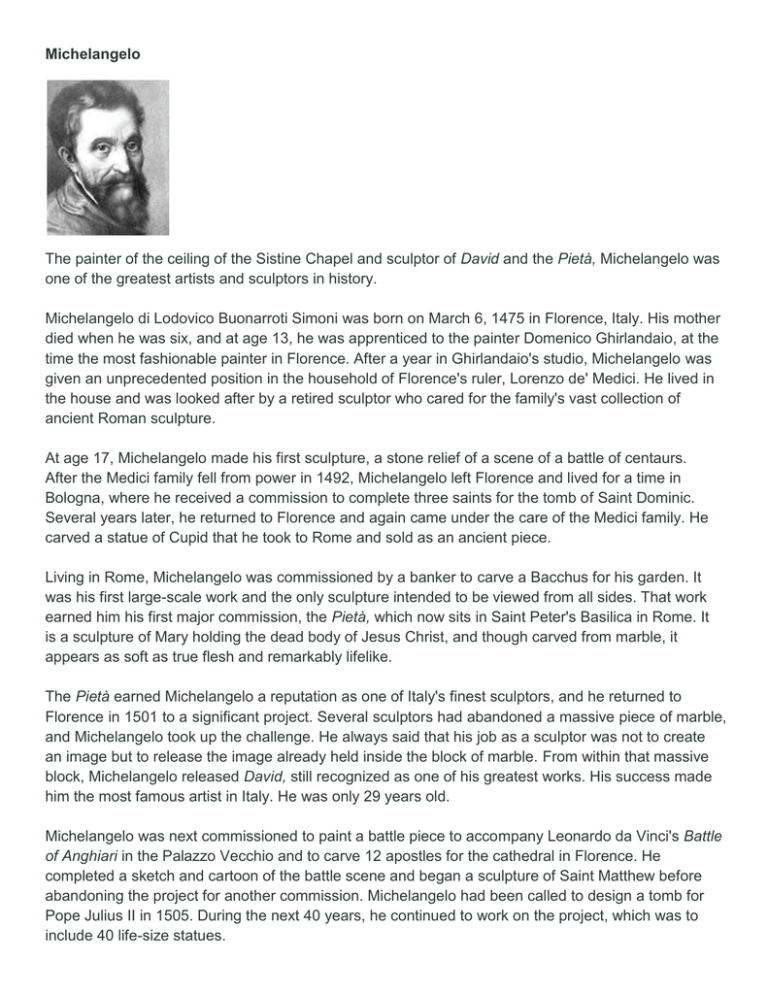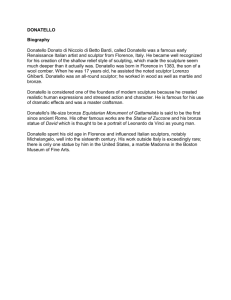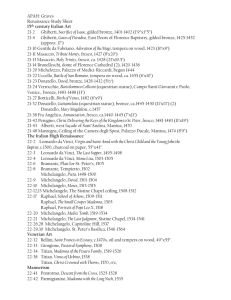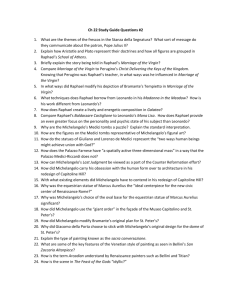Michelangelo The painter of the ceiling of the Sistine Chapel and
advertisement

Michelangelo The painter of the ceiling of the Sistine Chapel and sculptor of David and the Pietà, Michelangelo was one of the greatest artists and sculptors in history. Michelangelo di Lodovico Buonarroti Simoni was born on March 6, 1475 in Florence, Italy. His mother died when he was six, and at age 13, he was apprenticed to the painter Domenico Ghirlandaio, at the time the most fashionable painter in Florence. After a year in Ghirlandaio's studio, Michelangelo was given an unprecedented position in the household of Florence's ruler, Lorenzo de' Medici. He lived in the house and was looked after by a retired sculptor who cared for the family's vast collection of ancient Roman sculpture. At age 17, Michelangelo made his first sculpture, a stone relief of a scene of a battle of centaurs. After the Medici family fell from power in 1492, Michelangelo left Florence and lived for a time in Bologna, where he received a commission to complete three saints for the tomb of Saint Dominic. Several years later, he returned to Florence and again came under the care of the Medici family. He carved a statue of Cupid that he took to Rome and sold as an ancient piece. Living in Rome, Michelangelo was commissioned by a banker to carve a Bacchus for his garden. It was his first large-scale work and the only sculpture intended to be viewed from all sides. That work earned him his first major commission, the Pietà, which now sits in Saint Peter's Basilica in Rome. It is a sculpture of Mary holding the dead body of Jesus Christ, and though carved from marble, it appears as soft as true flesh and remarkably lifelike. The Pietà earned Michelangelo a reputation as one of Italy's finest sculptors, and he returned to Florence in 1501 to a significant project. Several sculptors had abandoned a massive piece of marble, and Michelangelo took up the challenge. He always said that his job as a sculptor was not to create an image but to release the image already held inside the block of marble. From within that massive block, Michelangelo released David, still recognized as one of his greatest works. His success made him the most famous artist in Italy. He was only 29 years old. Michelangelo was next commissioned to paint a battle piece to accompany Leonardo da Vinci's Battle of Anghiari in the Palazzo Vecchio and to carve 12 apostles for the cathedral in Florence. He completed a sketch and cartoon of the battle scene and began a sculpture of Saint Matthew before abandoning the project for another commission. Michelangelo had been called to design a tomb for Pope Julius II in 1505. During the next 40 years, he continued to work on the project, which was to include 40 life-size statues. In 1508, Julius commissioned Michelangelo to paint the ceiling of the Sistine Chapel in the Vatican. Creating an architectural system on the ceiling, Michelangelo painted hundreds of figures on several planes, making the entire work feel as though it were three-dimensional. It is a highly ornamental work and includes nine stories from the biblical book Genesis and 12 prophets. It took Michelangelo four years, painting while lying on his back on scaffolding, to finish the immense work. After completing the Sistine Chapel ceiling, Michelangelo returned to carving the tomb for Julius— halting the work only when the pope died. Julius was succeeded by Leo X, the son of Lorenzo de' Medici. Leo asked Michelangelo to design a facade for the family parish church in Florence. The project was canceled before sculpture began, and the church remains without a facade. In 1520, Michelangelo began another commission for the Medici family—this time a pair of tombs. In the tombs, Michelangelo did architecturally what he had done in paint in the Sistine Chapel, treating the walls as vivid sculptures. Relations with the Medici family had at times been strained, and a new leader, Alessandro de' Medici, bore some rather open hostility. In 1534, Michelangelo fled Florence. Back in Rome, Michelangelo was once again summoned by the pope, this time Pope Paul III, who asked the artist to paint another portion of the Sistine Chapel. For the altar wall of the chapel, Michelangelo painted an enormous vision of the Last Judgment. After completing that enormous and bitter painting, Michelangelo took over the project of building Saint Peter's Basilica. The project had been started 30 years before but had essentially lain dormant. Michelangelo built three of the four crossing arms and a portion of the cupola before his death in Rome on February 18, 1564. His body was returned to Florence and buried at San Croce. Further Reading Beck, James H., Three Worlds of Michelangelo, 1999; Goldscheider, Ludwig, Michelangelo: Paintings, Sculptures, Architecture, 1963; Hartt, Frederick, Michelangelo, 1965. Select Citation Style: MLA MLA "Michelangelo." World History: The Modern Era. ABC-CLIO, 2010. Web. 11 Oct. 2010. <http://worldhistory.abc-clio.com/> back to top Entry ID: 304998 Server: WEB2 Referer: Sandro Botticelli One of the great artists of the early Italian Renaissance, Sandro Botticelli is best known for his painting Birth of Venus. Botticelli was born Alessandrodi Mariano dei Filipipi in 1444 in Florence, Italy, the son of a leather tanner. He probably acquired the name Botticelli from his rather rotund eldest brother, who was nicknamed "Il Botticello," or "The Barrel." Botticelli was educated in his early years, probably more so than other artists of the day. He was trained first under a goldsmith and later under the master painter Fra Filippo Lippi. Under Lippi, he painted frescoes in the Prato Cathedral. By 1470, Botticelli had established himself as a painter of some repute with his own studio. The commission for the seven Virtues, first given to Piero Pollaiuolo, was finished by Botticelli, who painted the final panel, Fortitude. Having attracted the patronage of the Medici family by 1475, he included their portraits in the Adoration of the Magi, which now hangs in London's National Gallery. Lorenzo de' Medici and another patron, Guaspare Lame, stand at the far right of the painting, along with Botticelli himself. The three Magi are portraits of three deceased Medicis. Botticelli's mastery of delicate, smallscale works is ably shown in that painting. When Giuliano de' Medici was killed in the Passi conspiracy in 1478, the Medici family turned to Botticelli to paint effigies of the eight conspirators for public ridicule. The highlight of Botticelli's early period is the fresco St. Augustine, painted for the Ognissanti Church, which shows a bishop experiencing an ecstatic vision. At the same time, Botticelli provided 19 illustrations for a commentary on Dante Alighieri's Divine Comedy. Dante's imagery and thought permeate Botticelli's work. The commentary connected Botticelli with Lorenzo de Pierfrancesco de' Medici, cousin of Lorenzo the Magnificent, who would be come Botticelli's most significant patron. For Lorenzo de Pierfrancesco de' Medici's wedding, Botticelli painted Primavera in 1478. The painting is a visual celebration of spring and love and clearly shows Botticelli's style in which human forms float over background scenery. Traveling to Rome in 1481 and 1482, Botticelli painted frescoes in the Sistine Chapel. Though now overshadowed by the more famous works of Michelangelo, it was a prestigious commission and helped further propel Botticelli's career. Botticelli became so enamored with the ancient art in Rome that he used inspirations of ancient pieces in each of the Sistine frescoes. Three scenes are from the life of Moses. Another is a series of popes. Upon his return to Florence, Botticelli painted devotional works as well as works designed to cater to the increasingly humanist leanings of the Medicis and others in Florentine society. It was at that time that he painted what may be his most famous work, Birth of Venus. Representing not a biblical story but a classical myth, Birth of Venus reflected the Florentine aristocracy's growing interest in their own past and in the mythology of ancient Greece and Rome. Sometimes called by those ignorant of art "Venus on the Half Shell," the painting shows Venus rising out of the sea on an open clam shell. Two wind gods have blown her toward land, and a nymph is waiting to cover her nakedness with a purple cloak. One can see in Birth of Venus the liberties that Botticelli took with the human form for the sake of the harmony of design and image. Venus' neck is strangely long, and her left arm hangs uncomfortably from her shoulder, but the viewer does not immediately see those manipulations. The overall impression of the painting is elegance and natural grace. Botticelli took similar liberties in many of his paintings, all to achieve an overall elegance and fluidity of lines. Birth of Venus may have been a recreation of an ancient painting long lost but remembered in literature. Botticelli recreated more ancient paintings in Mars and Venus and Calumny of Appelles. At the same time, he was making a successful business out of painting the Virgin Mary with her child, the most famous being Madonna of the Magnificat, which now hangs in Florence's Uffizi Gallery. By the 1490s, the heyday of the Medicis was coming to an end. Lorenzo the Magnificent died in 1492, and a fiery religious leader named Savonarola was preaching religious reform and the end of the world. In 1494, Charles VII invaded Florence, occupying the Medici Palace, and the family of Lorenzo the Magnificent went into exile. Lorenzo di Pierfrancesco remained, supporting the new leader, and Botticelli continued to paint, but his paintings took on a new religious fervor. St. Augustine in His Cell, Last Communion of St. Jerome, and the Agony in the Garden are famous examples. Like the Medici's reign, Botticelli's fame and fortune were coming to an end. The High Renaissance brought a new style that completely overshadowed Botticelli's work. Although he had maintained a prosperous studio for decades, he had no followers of merit. He died in Florence on May 17, 1510. Further Reading Argan, Giulio, Botticelli: Biographical and Critical Study, 1957; International Dictionary of Art and Artists, 1990; Salvani, Roberto, All the Paintings of Botticelli, 1965. Select Citation Style: MLA MLA "Sandro Botticelli." World History: The Modern Era. ABC-CLIO, 2010. Web. 11 Oct. 2010. <http://worldhistory.abc-clio.com/> Raphael The painter Raphael is considered one of the great masters of the Italian Renaissance. His work is revered all over the world, and unlike many of his contemporaries, he enjoyed great prestige and material success in his own lifetime. His paintings hang in the finest museums and are reproduced in thousands of books. Raphael was born on April 6, 1483 in Urbino, Italy, the son of a successful artist. Although his father died when he was 11 years old, Raphael was surrounded by the talented and wealthy as he grew up. At 16, he was sent to study in Perugia; at 20, he went to Siena and then Florence to study with the masters of those cities. He gained some recognition for his church paintings, commissioned portraits, and pictures of saints. In 1508, the course of Raphael's life changed when he was summoned to Rome to work for Pope Julius II. Julius had a powerful and heroic personality; he was moving into a new suite of rooms and wished to have them dramatically painted. Julius' favorite architect, Donato Bramante, was a fellow townsman and perhaps a relative of Raphael. After setting Raphael to a minor task, Julius was so impressed with his work that he dismissed other, more famed artists and put Raphael to work in his private chambers. The result is considered one of the high points of Raphael's art, though he was not yet 30 when he painted the walls of Julius' rooms, and he had little or no experience in painting frescoes when he began. On the walls of the Stanza della Segnatura, both pagan and Christian themes are brought together in brilliant, complex compositions that are emblematic of the Renaissance itself. Critics agree that Raphael's works harmonize the different elements of the Renaissance and raise them to their highest form. His pictures are not of conflict, but of balance. Throughout his life, Raphael learned from the work of others while not directly imitating it; elements of composition and color reflect the influence of Perugino, Leonardo da Vinci, Michelangelo, Fra Bartolommeo, and others. For those reasons, Raphael has been both admired and criticized for his work, which portrays subjects in an idealistic, perfected form. Many other frescoes and portraits were completed by Raphael under Julius' patronage. When Julius died in 1513, Raphael became a favorite of the next pope, Leo X. Both Leo and Raphael were men of even temperament who preferred to be happy; both were hard-working. Raphael produced an incredible number of masterpieces over the next few years, both for the pope and other patrons. Some of the most famous are the Sistine Madonna, Madonna of the Goldfinch (Raphael painted at least 50 Madonnas), The Holy Family under the Oak Tree (also called the Pearl Madonna), the Galatea (based on a pagan theme), St. Cecilia, and a portrait of Raphael's friend, Baldassare Castiglione, as well as portraits of both Julius II and Leo X. Leo heaped extra tasks on Raphael, which may have affected his health. Recent excavations in Rome had unearthed many ancient statues of gods and heroes, and in 1515, Leo appointed Raphael as superintendent of antiquities. Raphael was to preserve the admired, Greco-Roman treasures of the ancient world. In addition to many other assignments, the pope asked Raphael to decorate more rooms and to design a series of 10 tapestries, each more than 11 feet high. Raphael also inherited much of the work of his elderly relative Bramante, who had designed St. Peter's. Although work on St. Peter's was passed on to others, Raphael did complete some admirable architectural work. Today, all that stands of his buildings is the Palazzo Pandolfini, which was built from his plans posthumously. To keep up with his enormous workload, Raphael had many assistants to carry out his designs and ideas. Giorgio Vasari, an early biographer, claimed that Raphael's presence and personality caused men to "live in a state of natural harmony and agreement." He found time to enjoy the fine living that his position brought him. While he enjoyed a series of mistresses, Raphael was never tempted to marry and was apparently very happy with his well-paid bachelor status. He worked for the powerful, and his work was highly valued, yet he never involved himself in politics or the schemes of others. Raphael died at the age of 37 on April 6, 1520, apparently of a fever for which he was bled by doctors, then a common practice. One story says that his last mistress was with him until a priest came to administer the sacraments; the priest refused to enter until the mistress was sent away. Raphael's funeral took place on the Pantheon in Rome, and his last picture, The Transfiguration (probably finished by assistants), was displayed over his coffin. MLA "Raphael." World History: The Modern Era. ABC-CLIO, 2010. Web. 11 Oct. 2010. <http://worldhistory.abc-clio.com/> Server: WEB2 | Titian Titian was the greatest Italian Renaissance painter of the Venetian school. He has been one of the most imitated painters in history. Titian showed an astonishing grasp of all painting techniques, and his portraits, religious subjects, and mythological paintings are all considered masterpieces of their genres. Titian was born Tiziano Vecellio between 1485 and 1490 (though some have put the date as early as 1477) in Pieve di Cadore in the republic of Venice, which is now part of Italy. His father was a modest local official. Starting around the age of nine, Titian trained in the studio of Giovanni Bellini and then came under the influence of Giorgione, with whom he formed a close relationship. He helped Giorgione paint the external frescoes of the Fondaco dei Tedeschi in Venice between 1506 and 1508. When his mentor died in 1510, Titian took over the completion of a number of the master's paintings; there are several works in existence today whose authorship is unclear, which could be either Giorgione's or Titian's. In 1511, Titian accepted his first major commission, to paint three frescoes at the Scuola del Santo in Padua. When his former teacher Bellini died in 1516, Titian became the official painter to the republic of Venice. He spent these early years developing his own style of painting independent of Giorgione's, though a fusion of their two styles is evident in the painting Sacred and Profane Love (1516) at the Villa Borghese in Rome. Now in his prime, Titian produced a large number of original and brilliant paintings on religious and mythological themes, as well as a number of portraits. He painted a series of altarpieces at Santa Maria dei Frari in Venice between 1516 and 1518, characterized by the strong simple colors and the silhouetting of dark forms against light background that he favored during this period. His depiction of the Assumption anticipates the baroque style of painting in the way that the soaring movement of the Virgin Mary contradicts stable quattrocento and High Renaissance artistic conventions. The Pesaro altarpiece in the same church (painted during 1519-1526) uses a bold diagonal composition with architectural motifs to enhance the drama of the scene. Titian also painted some fine mythological works during this period, including the Worship of Venus, the Bacchanal, and Bacchus and Ariadne (1518-1523). In the early 1520s, a young woman named Cecila moved in with Titian and bore him two sons; the younger, Orazio, became his father's chief assistant. Titian married Cecilia in 1525; she gave birth to two daughters in the late 1520s. After Cecilia died around 1530, Titian was disconsolate and never remarried. His painting style changed to become more restrained and meditative. He replaced his contrasting colors with shades that complemented one another and were more subdued than the strong reds and blues that he had previously favored. His composition became less adventurous. For example, the Presentation of the Virgin (1534-1538) at the Accademia in Venice uses an almost quattrocento relief-like frieze composition. During the 1530s, Titian became increasingly famous throughout Europe. He met Holy Roman emperor Charles V in Bologna in 1530 and painted his portrait three years later. Pleased with the result, Charles appointed him court painter and made him Count Palatine and Knight of the Golden Spur. Italian princes sought his works; one of these is the Venus of Urbino (1538), named after its owner, the Duke of Urbino. Titian came under the influence of mannerism in the 1540s. He made his only trip to Rome during 1545-1546, where he was deeply impressed by Michelangelo's Last Judgement and by the Roman remains still extant there. During his stay, he painted the Danaë and his famous portrait of Pope Paul III and his nephews. Emperor Charles summoned Titian to Augsburg in 1548, where he had him paint two portraits of himself, an equestrian one and a calmer pose of the emperor seated in an armchair. In 1550, Titian painted a portrait of Charles' son, the future Philip II of Spain. Philip became one of Titian's greatest patrons and commissioned several erotic mythological works between 1550 and 1562, including Danaë, Venus and Adonis, Perseus and Andromeda, the Rape of Europa, Diana and Actaeon, Diana and Calisto, and The Death of Actaeon. Titian called these paintings "poesie," poetic visions of the mythological world in contrast to his earlier more realistic mythological paintings. Toward the end of his life, though his assistants continued to produce works in his earlier styles, Titian's own paintings became looser and more meditative. His Martyrdom of St. Lawrence (1550-1555) is in an almost mannerist style, but a revised version from 1564-1567 is much more about the way light creates and dissolves forms. The last painting he did was the Pieta (1573-1576), which was meant to adorn his own tomb and was finished posthumously by Palma Giovane. Titian's painting style was tremendously influential on the artists who followed him, especially his free and expressive brush techniques with oils. He was known for being greedy, and although he was wealthy, he claimed poverty in the hopes of inspiring pity and generosity in his patrons. He constantly exaggerated his age for the same reason, so it is impossible to pin down his birth date with any accuracy. He was, however, known for his elaborate hospitality and generosity toward his friends. Titian died on August 27, 1576. After his death, the art critic Giovanni Lomazzo said that he was "the sun amidst small stars not only among the Italians but all the painters of the world." Further Reading Cole, Bruce, and Adelheid Gealt. Art of the Western World: From Ancient Greece to Post-Modernism. New York: Summit Books, 1989; Cole, Bruce, Titian and Venetian Painting: 1450-1590, 2000; Pedrocco, Filipo, Titian, 2001. Select Citation Style: MLA MLA "Titian." World History: The Modern Era. ABC-CLIO, 2010. Web. 11 Oct. 2010. <http://worldhistory.abc-clio.com/> back to top Entry ID: 306679 Server: WEB2 | Client IP: 169.241.28.72 | Session ID: y2vntuqtw212eajp1acfcvjd DONATELLO (b. ca. 1386, Firenze, d. 1466, Firenze) Biography Donatello (Donato di Niccolò di Betto Bardi), master of sculpture in both marble and bronze, one of the greatest of all Italian Renaissance artists. A good deal is known about Donatello's life and career, but little is known about his character and personality, and what is known is not wholly reliable. He never married and he seems to have been a man of simple tastes. Patrons often found him hard to deal with in a day when artists' working conditions were regulated by guild rules. Donatello seemingly demanded a measure of artistic freedom. Although he knew a number of Humanists well, the artist was not a cultured intellectual. His Humanist friends attest that he was a connoisseur of ancient art. The inscriptions and signatures on his works are among the earliest examples of the revival of classical Roman lettering. He had a more detailed and wideranging knowledge of ancient sculpture than any other artist of his day. His work was inspired by ancient visual examples, which he often daringly transformed. Though he was traditionally viewed as essentially a realist, later research indicates he was much more. Donatello (diminutive of Donato) was the son of Niccolò di Betto Bardi, a Florentine wool carder. It is not known how he began his career, but it seems likely that he learned stone carving from one of the sculptors working for the cathedral of Florence about 1400. Some time between 1404 and 1407 he became a member of the workshop of Lorenzo Ghiberti, a sculptor in bronze who in 1402 had won the competition for the doors of the Florentine baptistery. Donatello's earliest work of which there is certain knowledge, a marble statue of David, shows an artistic debt to Ghiberti, who was then the leading Florentine exponent of International Gothic, a style of graceful, softly curved lines strongly influenced by northern European art. The David, originally intended for the cathedral, was moved in 1416 to the Palazzo Vecchio, the city hall, where it long stood as a civic-patriotic symbol, although from the 16th century on it was eclipsed by the gigantic David of Michelangelo, which served the same purpose. Other of Donatello's early works, still partly Gothic in style, are the impressive seated marble figure of St John the Evangelist for the cathedral façade and a wooden crucifix in the church of Santa Croce. The latter, according to an unproved anecdote, was made in friendly competition with Brunelleschi, a sculptor and an architect. The full power of Donatello first appeared in two marble statues, St Mark and St George (both completed c. 1415), for niches on the exterior of Or San Michele, the church of Florentine guilds (St George has been replaced by a copy; the original is now in the Bargello). Here, for the first time since classical antiquity and in striking contrast to medieval art, the human body is rendered as a self-activating, functional organism, and the human personality is shown with a confidence in its own worth. The same qualities came increasingly to the fore in a series of five prophet statues that Donatello did beginning in 1416 for the niches of the campanile, the bell tower of the cathedral (all these figures, together with others by lesser masters, were later removed to the Museo dell'Opera del Duomo). The statues were of a beardless and a bearded prophet, as well as a group of Abraham and Isaac (1416-21) for the eastern niches; the so-called Zuccone ("pumpkin," because of its bald head); and Jeremiah for the western niches. The Zuccone is deservedly famous as the finest of the campanile statues and one of the artist's masterpieces. In both the Zuccone and the Jeremiah (1427-35), their whole appearance, especially highly individual features inspired by ancient Roman portrait busts, suggests classical orators of singular expressive force. The statues are so different from the traditional images of Old Testament prophets that by the end of the 15th century they could be mistaken for portrait statues. A pictorial tendency in sculpture had begun with Ghiberti's narrative relief panels for the north door of the baptistery, in which he extended the apparent depth of the scene by placing boldly rounded foreground figures against more delicately modeled settings of landscape and architecture. Donatello invented his own bold new mode of relief in his marble panel St. George Killing the Dragon (1416-17, base of the St. George niche at Or San Michele). Known as schiacciato ("flattened out"), the technique involved extremely shallow carving throughout, which created a far more striking effect of atmospheric space than before. The sculptor no longer modeled his shapes in the usual way but rather seemed to "paint" them with his chisel. A blind man could "read" a Ghiberti relief with his fingertips; a schiacciato panel depends on visual rather than tactile perceptions and thus must be seen. Donatello continued to explore the possibilities of the new technique in his marble reliefs of the 1420s and early 1430s. The most highly developed of these are The Ascension, with Christ Giving the Keys to St Peter, which is so delicately carved that its full beauty can be seen only in a strongly raking light; and the Feast of Herod (1433-35), with its perspective background. The large stucco roundels with scenes from the life of St John the Evangelist (about 1434-37), below the dome of the old sacristy of San Lorenzo, Florence, show the same technique but with colour added for better legibility at a distance. Meanwhile, Donatello had also become a major sculptor in bronze. His earliest such work was the more than life-size statue of St Louis of Toulouse (c. 1413) for a niche at Or San Michele (replaced half a century later by Verrocchio's bronze group of Christ and the doubting Thomas). Toward 1460 the St. Louis was transferred to Santa Croce and is now in the museum attached to the church. Early scholars had an unfavourable opinion of St Louis, but later opinion held it to be an achievement of the first rank, both technically and artistically. The garments completely hide the body of the figure, but Donatello successfully conveyed the impression of harmonious organic structure beneath the drapery. Donatello had been commissioned to do not only the statue but the niche and its framework. The niche is the earliest to display Filippo Brunelleschi's new Renaissance architectural style without residual Gothic forms. Donatello could hardly have designed it alone; Michelozzo, a sculptor and architect with whom he entered into a limited partnership a year or two later, may have assisted him. In the partnership, Donatello contributed only the sculptural centre for the fine bronze effigy on the tomb of the schismatic pope John XXIII in the baptistery; the relief of the Assumption of the Virgin on the Brancacci tomb in Sant'Angelo a Nilo, Naples; and the balustrade reliefs of dancing angels on the outdoor pulpit of Prato Cathedral (1433-38). Michelozzo was responsible for the architectural framework and the decorative sculpture. The architecture of these partnership projects resembles that of Brunelleschi and differs sharply from that of comparable works done by Donatello alone in the 1430s. All of his work done alone shows an unorthodox ornamental vocabulary drawn from both classical and medieval sources and an un-Brunelleschian tendency to blur the distinction between the architectural and the sculptural elements. Both the Annunciation tabernacle in Santa Croce and the Cantoria (the singer's pulpit) in the Duomo (now in the Museo dell'Opera del Duomo) show a vastly increased repertory of forms derived from ancient art, the harvest of Donatello's long stay in Rome (143033). His departure from the standards of Brunelleschi produced an estrangement between the two old friends that was never repaired. Brunelleschi even composed epigrams against Donatello. During his partnership with Michelozzo, Donatello carried out independent commissions of pure sculpture, including several works of bronze for the baptismal font of San Giovanni in Siena. The earliest and most important of these was the Feast of Herod (1423-27), an intensely dramatic relief with an architectural background that first displayed Donatello's command of scientific linear perspective, which Brunelleschi had invented only a few years earlier. To the Siena font Donatello also contributed two statuettes of Virtues, austerely beautiful figures whose style points toward the Virgin and angel of the Santa Croce Annunciation, and three nude putti, or child angels (one of which was stolen and is now in the Berlin museum). These putti, evidently influenced by Etruscan bronze figurines, prepared the way for the bronze David, the first large- scale, free-standing nude statue of the Renaissance. Well-proportioned and superbly poised, it was conceived independently of any architectural setting. Its harmonious calm makes it the most classical of Donatello's works. The statue was undoubtedly done for a private patron, but his identity is in doubt. Its recorded history begins with the wedding of Lorenzo the Magnificent in 1469, when it occupied the centre of the courtyard of the Medici palace in Florence. After the expulsion of the Medici in 1496, the statue was placed in the courtyard of the Palazzo Vecchio. Whether the David was commissioned by the Medici or not, Donatello worked for them (1433-43), producing sculptural decoration for the old sacristy in San Lorenzo, the Medici church. Works there included 10 large reliefs in coloured stucco and two sets of small bronze doors, which showed paired saints and apostles disputing with each other in vivid and even violent fashion. In 1443, when Donatello was about to start work on two much more ambitious pairs of bronze doors for the sacristies of the cathedral, he was lured to Padua by a commission for a bronze equestrian statue of a famous Venetian condottiere, Erasmo da Narmi, popularly called Gattamelata (The Honeyed Cat), who had died shortly before. Such a project was unprecedented - indeed, scandalous - for since the days of the Roman Empire bronze equestrian monuments had been the sole prerogative of rulers. The execution of the monument was plagued by delays. Donatello did most of the work between 1447 and 1450, yet the statue was not placed on its pedestal until 1453. It portrays Gattamelata in pseudo-classical armour calmly astride his mount, the baton of command in his raised right hand. The head is an idealized portrait with intellectual power and Roman nobility. This statue was the ancestor of all the equestrian monuments erected since. Its fame, enhanced by the controversy, spread far and wide. Even before it was on public view, the king of Naples wanted Donatello to do the same kind of equestrian statue for him. In the early 1450s, Donatello undertook some important works for the Paduan Church of San Antonio: a splendidly expressive bronze crucifix and a new high altar, the most ambitious of its kind, unequaled in 15th-century Europe. Its richly decorated architectural framework of marble and limestone contains seven life-size bronze statues, 21 bronze reliefs of various sizes, and a large limestone relief, Entombment of Christ. The housing was destroyed a century later, and the present arrangement, dating from 1895, is wrong both aesthetically and historically. The majestic Madonna, with an austere frontal pose seemingly a conscious reference to an earlier venerated image, and the delicate, sensitive St Francis are particularly noteworthy. The finest of the reliefs are the four miracles of St Anthony, wonderfully rhythmic compositions of great narrative power. Donatello's mastery in handling large numbers of figures (one relief has more than 100) anticipates the compositional principles of the High Renaissance. Donatello was apparently inactive during the last three years at Padua, the work for the San Antonio altar unpaid for and the Gattamelata monument not placed until 1453. He had dismissed the large force of sculptors and stone masons used on these projects. Offers of other commissions reached him from Mantua, Modena, Ferrara, and even perhaps from Naples, but nothing came of them. Clearly, Donatello was passing through a crisis that prevented him from working. He was later quoted as saying that he almost died "among those frogs in Padua." In 1456 the Florentine physician Giovanni Chellini noted in his account book that he had successfully treated the master for a protracted illness. Donatello completed only two works between 1450 and 1455: the wooden statue St John the Baptist in Santa Maria Gloriosa dei Frari, Venice, shortly before his return to Florence; and an even more extraordinary figure of Mary Magdalen in the Florentine baptistery. Both works show new insight into psychological reality; Donatello's formerly powerful bodies have become withered and spidery, overwhelmed, as it were, by emotional tensions within. When the Magdalen was damaged in the 1966 flood at Florence, restoration work revealed the original painted surface, including realistic flesh tones and golden highlights throughout the saint's hair. During Donatello's absence, a new generation of sculptors who excelled in the sensuous treatment of marble surfaces had arisen in Florence. Thus Donatello's wooden figures must have been a shock. With the change in Florentine taste, all of Donatello's important commissions came from outside Florence. They included the dramatic bronze group Judith and Holofernes (later acquired by the Medici and now standing before the Palazzo Vecchio) and a bronze statue of St John the Baptist for Siena Cathedral, for which he also undertook in the late 1450s a pair of bronze doors. This ambitious project, which might have rivaled Ghiberti's doors for the Florentine baptistery, was abandoned about 1460 for unknown reasons (most likely technical or financial). Only two reliefs for them were executed; one of them is probably the Lamentation panel now in the Victoria and Albert Museum, London. The last years of Donatello's life were spent designing twin bronze pulpits for San Lorenzo, and, thus, again in the service of his old patrons the Medici, he died. Covered with reliefs showing the passion of Christ, the pulpits are works of tremendous spiritual depth and complexity, even though some parts were left unfinished and had to be completed by lesser artists. © Web Gallery of Art, created by Emil Kren and Daniel Marx. EYCK, Jan van (b. before 1395, Maaseik, d. 1441, Bruges) Biography Jan van Eyck, the most famous and innovative Flemish painter of the 15th century, is thought to have come from the village of Maaseyck in Limbourg. No record of his birthdate survives, but it is believed to have been about 1390; his career, however, is well documented. He was employed (1422-24) at the court of John of Bavaria, count of Holland, at The Hague, and in 1425 he was made court painter and valet de chambre to Duke Philip the Good of Burgundy. He became a close member of the duke's court and undertook several secret missions for him, including a trip (1428-29) to Spain and Portugal in connection with negotiations that resulted in the marriage (1430) of Philip of Burgundy and Isabella of Portugal. Documents show that in 1432-33 van Eyck bought a house in Bruges. He signed and dated a number of paintings between 1432 and 1439, all of which are painted in oil and varnished. According to documents, he was buried on July 9, 1441. Van Eyck has been credited traditionally with the invention of painting in oils, and, although this is incorrect, there is no doubt that he perfected the technique. He used the oil medium to represent a variety of subjects with striking realism in microscopic detail; for example, he infused painted jewels and precious metals with a glowing inner light by means of subtle glazes over the highlights. Van Eyck's most famous and most controversial work is one of his first, the Ghent altarpiece (1432), a polyptych consisting of twenty panels in the Church of St. Bavo, Ghent. On the frame is an incomplete inscription in Latin that identifies the artists of the work as Hubert and Jan van Eyck. The usual interpretation is that Hubert van Eyck (d. Sept. 18, 1426) was the brother of Jan and that he was the painter who began the altarpiece, which Jan then completed. Another interpretation is that Hubert was neither Jan's brother nor a painter, but a sculptor who carved an elaborate frame for the altar. Because of this controversy, attribution of the panels, which vary somewhat in scale and even in style, has differed, according to the arguments of scholars who have studied the problem. Equally famous is the wedding portrait of Giovanni Arnolfini and his wife (1434; National Gallery, London), which the artist signed "Johannes de Eyck fuit hic 1434" (Jan van Eyck was here), testimony that he witnessed the ceremony. Other important paintings are the Madonna of Chancellor Rolin (1433-34 Louvre, Paris) and the Madonna of Canon van der Paele (1436; Groeningen Museum, Bruges). MASACCIO (b. 1401, San Giovanni Valdarno, d. 1428, Roma) Biography Masaccio (1401-1427?), the first great painter of the Italian Renaissance, whose innovations in the use of scientific perspective inaugurated the modern era in painting. Masaccio, originally named Tommaso Cassai, was born in San Giovanni Valdarno, near Florence, on December 21, 1401. He joined the painters guild in Florence in 1422. His remarkably individual style owed little to other painters, except possibly the great 14th-century master Giotto. He was more strongly influenced by the architect Brunelleschi and the sculptor Donatello, both of whom were his contemporaries in Florence. From Brunelleschi he acquired a knowledge of mathematical proportion that was crucial to his revival of the principles of scientific perspective. From Donatello he imbibed a knowledge of classical art that led him away from the prevailing Gothic style. He inaugurated a new naturalistic approach to painting that was concerned less with details and ornamentation than with simplicity and unity, less with flat surfaces than with the illusion of three dimensionality. Together with Brunelleschi and Donatello, he was a founder of the Renaissance. Only four unquestionably attributable works of Masaccio survive, although various other paintings have been attributed in whole or in part to him. All of his works are religious in nature—altarpieces or church frescoes. The earliest, a panel, the Madonna with St. Anne (circa 1423, Uffizi, Florence), shows the influence of Donatello in its realistic flesh textures and solidly rounded forms. The fresco Trinity (c. 1425, Santa Maria Novella, Florence) used full perspective for the first time in Western art. His altarpiece for Santa Maria del Carmine, Pisa (1426), with its central panel of the Adoration of the Magi (now in the Staatliche Museen, Berlin), was a simple, unadorned version of a theme that was treated by other painters in a more decorative, ornamental manner. The fresco series for the Brancacci Chapel in Santa Maria del Carmine, Florence (about 1427) illustrates another of his great innovations, the use of light to define the human body and its draperies. In these frescoes, rather than bathing his scenes in flat uniform light, he painted them as if they were illuminated from a single source of light (the actual chapel window), thus creating a play of light and shadow (chiaroscuro) that gave them a natural, realistic quality unknown in the art of his day. Of these six fresco scenes, Tribute Money and the Expulsion from Paradise are considered his masterpieces. Masaccio's work exerted a strong influence on the course of later Florentine art and particularly on the work of Michelangelo. He died in Rome in 1427 or 1428.







